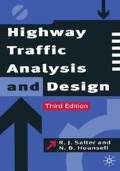Abstract
Two approaches are in common use for calculating traffic delays at signal-controlled junctions. The first method, based on steady-state queueing theory, is relevant to situations of relatively constant traffic demand where demand does not exceed about 90 per cent of capacity. More recently, time-dependent queueing theory has been developed, applicable to all traffic states including time-varying demand and ‘oversaturation’.
Preview
Unable to display preview. Download preview PDF.
Author information
Authors and Affiliations
Copyright information
© 1996 Y. Salter and N. B. Hounsell
About this chapter
Cite this chapter
Salter, R.J. (1996). Delay at signal-controlled intersections. In: Highway Traffic Analysis and Design. Palgrave, London. https://doi.org/10.1007/978-1-349-13423-6_43
Download citation
DOI: https://doi.org/10.1007/978-1-349-13423-6_43
Publisher Name: Palgrave, London
Print ISBN: 978-0-333-60903-3
Online ISBN: 978-1-349-13423-6
eBook Packages: EngineeringEngineering (R0)

